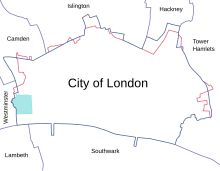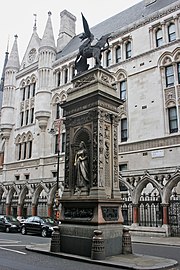City of London
| City of London | |
|---|---|
| status |
City , District sui generis and ceremonial county |
| region | Greater London |
| Administrative headquarters | Guildhall |
| surface | 2.90 km² |
| Residents | 8,706 |
| Population density | 3002 inhabitants / km² |
| was standing | June 2018 |
| ONS code | 00AA |
| Website | www.cityoflondon.gov.uk |
The City of London is a district and the historical and economic center of the Greater London region of England . The district is often referred to simply as The City or Square Mile (square mile, according to its area).
The City of London is the smallest administrative district of London by area and population; It is the only sui generis district that is not counted among the 32 London Boroughs and has a unique local administrative authority: The City of London Corporation , with the local Lord Mayor of London, is directly subordinate to the British monarch and, in the medieval tradition, has several offices and offices that have existed for centuries over wider powers than ordinary districts such as B. UK tax exemption and the City of London Police, which is independent from Greater London . In practice, however, it is a district administration that is analogous to the boroughs and which is responsible for the planning of theGreater London Authority is subordinate. While there are no administrative counties at the administrative level in Greater London, unlike in other regions , there is also the ceremonial county of the City of London , which is independent of the ceremonial county of Greater London .
Although it only has a few thousand residents, there are several hundred thousand employees in the City of London on weekdays. Based on its status as an independent legal entity, it is one of the largest financial centers in the world (see also the list of financial centers of global importance ). The City of London is not just a ceremonial county, it has its own form of government, with the majority of the votes not in people, but in corporations and corporations.
expansion
To the west, the City of London is bordered by the City of Westminster , to the northwest by Camden , to the north by Islington , to the northeast by Hackney , to the east by Tower Hamlets and to the south by the Thames and Southwark . The Tower of London is contrary to the prevailing opinion is not in the city but just outside in Tower Hamlets. In the river, the border runs in the middle, with the exception of London Bridge and Blackfriars Bridge , which are administered in their entirety by the City.
The City of London was once bounded by the London Wall . This fortification had already been built by the Romans to protect the strategically located port city of Londinium . The wall has now almost completely disappeared, only individual sections have been preserved. A significant section of the Museum of London was discovered on December 29, 1940 during clean-up operations after a German air raid. The previous city gates were Ludgate , Newgate , Aldersgate , Cripplegate , Bishopsgate and Aldgate .
From 1550 to 1899, the district of Southwark south of the Thames also belonged to the City under the name Ward of Bridge Without , today it is in the London Borough of Southwark . Over the centuries, the boundaries north of the Thames remained virtually unchanged. In 1993, however, adjustments were made in individual places by swapping parcels, as the boundaries no longer made sense everywhere due to urban development. Overall, there was a small increase in space.
particularities

The City of London has a special political status. The reason for this are the privileges granted by the crown over the centuries, which have not yet been revoked or fundamentally revised. The City is administered by the City of London Corporation . The corporation is chaired by the Lord Mayor of London . This office should not be confused with that of the Mayor of London . The election process for the corporation does not correspond to the usual democratic principles, as the business representatives exert a disproportionate influence. The City of London is divided into 25 wards .
Within the city there are two legally independent enclaves , the Inner Temple and the Middle Temple, next to the Royal Courts of Justice . Although part of the ceremonial county, they are not administered by the corporation. The City of London Corporation owns many parks and forests in and around London. This includes Hampstead Heath and most of Epping Forest . It has three market halls : the Smithfield Market within its own boundaries as well as the Old Spitalfields Market and the Billingsgate Fish Market ( German Fischmarkt am Quai) in the Tower Hamlets district .
Since the reign of Elizabeth I , it has been a tradition for the respective British monarch to submit a request to the Lord Mayor of London at Temple Bar before entering the City of London . As a sign of loyalty, the Lord Mayor then presents the Sword of State . However, the Lord Mayor does not have the right - as is sometimes assumed - to deny the monarch access to the city.
The City of London has its own police authority , the City of London Police (the rest of the city of Greater London falls under the authority of the Metropolitan Police ). The corporation operates the City Bridge Trust , which maintains five major bridges. The City Health Authority is responsible for all port facilities and controls imported goods at Heathrow Airport .
history
| year | Residents | Population density |
|---|---|---|
| 1700 | 208,000 | approx. 71,700 inhabitants / km² |
| 1750 | 144,000 | approx. 49,600 inhabitants / km² |
| 1801 | 128.129 | 44,182 inhabitants / km² |
| 1841 | 123,563 | 42,608 inhabitants / km² |
| 1881 | 50,659 | 17,469 inhabitants / km² |
| 1901 | 26,846 | 9257 inhabitants / km² |
| 1921 | 13,709 | 4727 inhabitants / km² |
| 1951 | 5,324 | 1836 Ew./km² |
| 1971 | 4.234 | 1460 inhabitants / km² |
| 2011 | 7,375 | 2543 inhabitants / km² |
| 2014 | 8,072 | 2783 inhabitants / km² |
| 2016 | 9,401 | 3242 inhabitants / km² |
The City of London has had the right to self-government since 886, when King Alfred the Great appointed his son-in-law Æthelred as governor of London. Alfred made sure that the traders from northwest Europe had enough accommodation. This offer was later extended to dealers from the Baltic Sea region and Italy. In the city, a separate legal system developed for the dealers. In the 10th century, King Æthelstan granted the city the right to operate eight mints. This was a sign of particular prosperity, as Winchester , the capital of England at the time , had only six mints.
After the Battle of Hastings in 1066, William the Conqueror's army marched to Southwark but was unable to occupy London Bridge or conquer the city. After the Normans sacked the surrounding areas , the Anglo-Saxon nobility in Berkhamsted surrendered . William rewarded the steadfastness of the Londoners and in 1075 recognized their privileges with a royal charter. The City of London was one of the few institutions in which the Anglo-Saxons retained some degree of authority. But William had the fortresses Tower of London , Baynard's Castle and Montfitchet Castle built to control the city.
King Henry I gave London in 1132 the status of a County (county). The forerunner of the City of London Corporation was established in 1141 . The city was partially destroyed by a fire in 1212 and completely destroyed by another major fire in 1666, the Great Fire of London . 80% of the City of London was destroyed.
During the 19th and almost the entire 20th century, the city's population steadily declined as many residential buildings were demolished to make way for office buildings. Numerous high-rise buildings were built in the 1970s. The 183 m high Tower 42 (formerly NatWest Tower ), completed in 1980, is Great Britain's first skyscraper .
Margaret Thatcher's neoliberal deregulation of the City of London - “ Big Bang Day ” became famous on October 27, 1986 - had enormous consequences and turned finance capital into a significant force. After the deregulation, the US investment banks significantly increased their staff in London. In 1984 Goldman Sachs employed just 140 people on the Thames; In 1988 there were already 800 and in 2013 there were 6000.
Since the beginning of the 1990s the population has increased slightly again; however, it cannot be assumed that it will rise well above 10,000. New living space is mainly being created in commercial buildings from the first half of the 20th century that no longer meet the requirements of large companies. The largest residential area in the city is the Barbican Estate , a sprawling complex of brutalist architecture that is home to the Barbican Center, one of London's most important cultural centers. To meet the space requirements of the financial industry, new skyscrapers are planned, such as B. the project 22 Bishopsgate .
population
The population consists of 78.5% whites (57.5% British, 2.4% Irish, 18.6% other whites), 12.7% Asians (2.9% Indians, 0.2% Pakistani, 3rd , 1% Bangladeshi, 3.6% Chinese, 2.9% other Asians), 3.9% blacks (1.3% African, 0.6% Caribbean, 0.7% other black), 0.9% Arab , and 3.9% mixed together.
Attractions
- St Paul's Cathedral
- Guildhall
- Bank of England
- Old Bailey
- Royal Exchange
- Mansion House
- London Wall
- Museum of London
- monument
- College of Arms
- St. Bartholomew-the-Great-Abbey Church
- Mithras Temple (Roman Ruins)
- The Gherkin
- Temple Church
- various markets, including Leadenhall Market
directly adjacent:
literature
- Peter Mansfeld (Photos: Adam Reiser): The magic mile . In: Geo-Magazin. Hamburg 1978, 8, pp. 98-120. (Informative experience report about the "City of London") ISSN 0342-8311
Web links
- City of London Corporation (county council)
- Martin Parr; What really goes on inside the City of London? ( Memento from February 19, 2016 in the Internet Archive ) The Guardian, February 19, 2016
- 360 ° panorama pictures - interactive London sights
Individual evidence
- ↑ Mid 2018 Estimates of the population for the UK, England and Wales, Scotland and Northern Ireland
- ↑ Financial Center City of London - The Power of the Square Mile , WOZ No. 11/2012 of March 15, 2012
- ^ The City and London Borough Boundaries Order 1993
- ↑ http://news.efinancialcareers.com/de-de/138438/wie-londoner-banker-den-tod-margaret-thatchers-betrauern/
- ↑ John Lanchester: The Discreet State within the State , May 11, 2016
- ^ Population Estimates for UK, England and Wales, Scotland and Northern Ireland - Office for National Statistics. Accessed April 21, 2018 (English).
Coordinates: 51 ° 31 ′ N , 0 ° 5 ′ W





